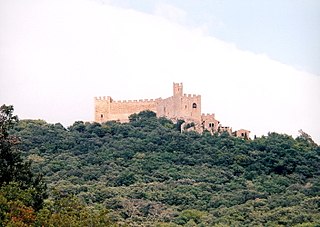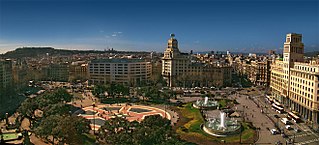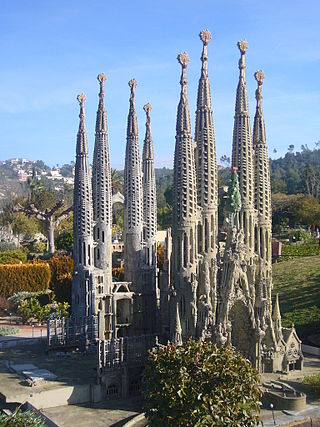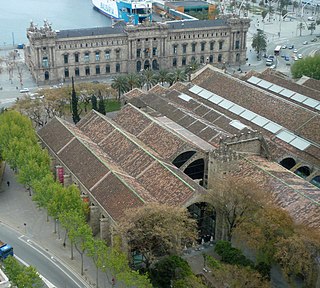
La Jonquera is a municipality in the comarca of l'Alt Empordà, in Catalonia, Spain. It is situated next to the border with Northern Catalonia, nowadays France, opposite the municipality of Le Perthus.

The Palace of the Generalitat of Catalonia is a historic palace in Barcelona, Catalonia, Spain. It houses the offices of the Presidency of the Generalitat de Catalunya. It is one of the few buildings of medieval origin in Europe that still functions as a seat of government and houses the institution that originally built it.

Olivella is a municipality in Catalonia, in the province of Barcelona, Spain. It is situated in the comarca of Garraf.

Malgrat de Mar is a municipality in the comarca of the Maresme, in the province of Barcelona, Catalonia, Spain. It is located on the Barcelona Coast between Santa Susanna and Blanes. A local road runs from the town to the main N-II road, while the B-682 connects it with Blanes, Lloret de Mar and Tossa de Mar. It is served by a RENFE railway station on the R1 line between Barcelona and Maçanet-Massanes.

Passeig de Gràcia or Paseo de Gracia is one of the major avenues in Barcelona and one of its most important shopping and business areas, containing several of the city's most celebrated pieces of architecture. It is located in the central part of Eixample, stretching from Plaça Catalunya to Carrer Gran de Gràcia.

Gran Via de les Corts Catalanes, more simply known as Gran Via, is one of Barcelona's major avenues. With a length of 13.1 km (8.1 mi), it is the longest street in Catalonia and the 2nd longest in Spain, after Gran Vía de la Manga, in La Manga del Mar Menor, but is the one with most street numbers in Spain.

Plaça de Catalunya is a large square in central Barcelona that is generally considered to be both its city centre and the place where the old city and the 19th century-built Eixample meet.

Sakya Tashi Ling is a monastery belonging to one of four Buddhist schools from Tibet, the Sakyapa tradition. It is an ancient order that follows the Tibetan spiritual leader and ancient king Sakya Trizin. The monastery is ruled by Lama Jamyang Tashi Dorje. It was built in 1905 by a family of "indians", called the Palau Novella which passed into the hands of the Buddhist community, Sakya Tashi Ling. They restored the building and installed a museum inside. It was re-established in July 1996, in the municipality of Olivella in the comarca of Garraf, Barcelona, Catalonia, Spain.

The Barcelona–Vallès Line is an unconnected standard gauge rapid transit and commuter railway line linking Barcelona with Sabadell and Terrassa via the Collserola mountain range, in Catalonia, Spain. Its name refers to the Catalan historical region of Vallès, whereby most part of the line runs. Plaça de Catalunya station serves as the Barcelona terminus of the line, where almost all its trains either start or terminate. The line then continues northwards and branches off twice before leaving the city limits. Its main route splits in two in Sant Cugat del Vallès, forming two major branches to Sabadell and Terrassa. It has 40 passenger stations in operation and a total line length of 48.1 kilometres (29.9 mi).

Rail transport in Catalonia operates on three rail gauges and services are operated by a variety of public operators:
The Battle of Albesa was a follow-up to the Battle of Torà that took place 25 February 1003 at Al-Qaṣr al-Māša (Albesa), near Balagî (Balaguer), between the united Christian forces of the Catalan counties and the Islamic forces of the Caliphate of Córdoba. It was one of the border skirmishes associated with the interminable razzias of the Reconquista, described as "a simple encounter between local forces" and "a local action without overarching importance", though both these views are called into question by the assemblage of important Catalan nobles at the battle and the Muslim reprisal which followed.

Diagonal Mar i el Front Marítim del Poblenou is a neighborhood in the Sant Martí district of Barcelona, Catalonia, Spain.

Muntanyola is a municipality in the comarca of Osona, Catalonia, northern Spain.

Catalunya en Miniatura is a miniature park inaugurated in 1983 in Torrelles de Llobregat, 17 km (11 mi) from Barcelona. The park is 60,000 m2 (650,000 sq ft), 35,000 m2 (380,000 sq ft) of them devoted to the scale models, it is one of the largest miniature parks in the world, and the largest of the 14 miniature building exhibitions present in Europe. It displays 147 models of palaces, churches, bridges and other buildings from Catalonia and Mallorca and it includes all the major works by the renowned architect Antoni Gaudí.

The Garraf Massif is a mountain range of the Catalan Coastal Range, Catalonia, Spain. Its cliffs reach the Mediterranean waters. Its highest point on the coastal side is La Morella, 593 metres above sea level and further inland rises the higher, although less conspicuous, Montau.

CaixaForum Barcelona is a cultural center in Barcelona, Catalonia, Spain. Located in the Montjuïc area in a former Modernist textile factory designed by Josep Puig i Cadafalch, it is owned by the not-for-profit banking foundation "la Caixa". After a restoration of the building, the art center opened its doors in 2002 and since then it hosts temporary art exhibitions and cultural events.
The Gabinet de les Arts Gràfiques, in English Graphic Arts Cabinet, is a museum opened in 1942 and located in the Palau Reial de Pedralbes in Barcelona. Together with Museu de les Arts Decoratives and the Museu Tèxtil i d'Indumentària is part of the Disseny Hub Barcelona.

Religion in Catalonia is diversified. Since the Expulsion of the Jews and the Moriscos in the late 15th and early 17th centuries respectively, virtually all the population was Christian, specifically Catholic, but since the 1980s there has been a trend of rapid decline of Christianity, also driven since the 1980s by the religious authorities' association with Francoist Spain. Nevertheless, according to the most recent study sponsored by the government of Catalonia, as of 2016, 61.9% of the Catalans identify as Christians, up from 56.5% in 2014, of whom 58.0% Catholics, 3.0% Protestants and Evangelicals, 0.9% Orthodox Christians and 0.6% Jehovah's Witnesses. At the same time, 16.0% of the population identify as atheists, 11.9% as agnostics, 4.8% as Muslims, 1.3% as Buddhists, and a further 2.4% as being of other religions.

Montargull is a scattered village aggregated to the municipality of Artesa de Segre, at La Noguera county, in Catalonia, Spain. It is located at the highway that goes from Artesa de Segre to the Pallars Jussà county. It got its name due to its location on a hill marking the end of the Serra de Comiols, and the start of a plain known by the same name of the village. On this plain there are crops of wheat and barley, favored by a fairly arid mediterranean weather mildened by the proximity of the mountains. The climate is typical from the mid Segre, with orographic features similar to the Central Depression of Catalonia.

The Maritime Museum of Barcelona is located in the building of Drassanes Reials de Barcelona, the royal arsenal of Barcelona, dedicated to shipbuilding between the thirteenth century and eighteenth century. The first mention of these arsenals date from 1243 in a document indicating the boundaries of the city of Barcelona where it mentions its shipyard.


















